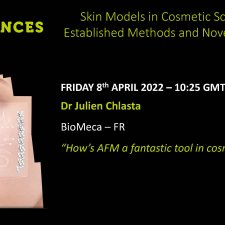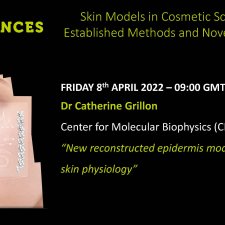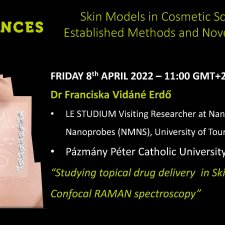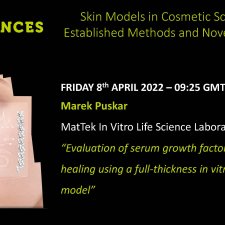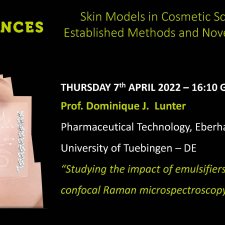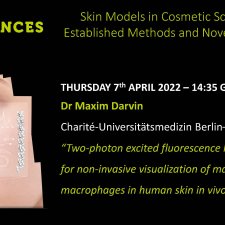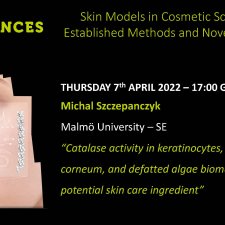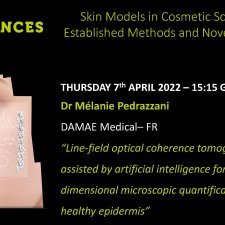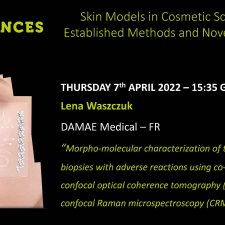Notice
Dr Nikolett Kis - Investigation of the effect of chemical permeation enhancer glycols on the skin measuring by NMR and Raman spectroscopy
- document 1 document 2 document 3
- niveau 1 niveau 2 niveau 3
Descriptif
Dermal drug delivery is an attractive alternative to conventional drug administration due to its advantages. However, the outermost layer of the skin, the stratum corneum (SC), provides an effective barrier against dermal permeation. Permeation enhancement techniques, such as chemical permeation enhancer glycols, are widely used to overcome the barrier function of the skin.
The aim of this research work was to examine three well-known glycols to define their effects on the SC structure and define the correlation with their permeation enhancer properties. We used NMR spectroscopy to characterize the molecular structure of SC, and Raman spectroscopy to examine the permeation of a model drug into the different skin layers.
The results of NMR measurements reviled that the glycols increase the mobility of SC components, furthermore, they affect the mobility of keratin filaments. A saturation level for all glycols was detected, after which the addition of chemicals did not increase the mobility. The results of Raman spectroscopy correlated well with the results of NMR measurements because a significant permeation enhancer effect of glycols was observed.
Thème
Dans la même collection
-
Dr Julien Chlasta - How’s AFM a fantastic tool in cosmetic research?
Atomic force microscopy (AFM) is a tool for nanoscale analysis-based approach allowing to obtain mechanical information about structures
-
Dr Catherine Grillon - New reconstructed epidermis models closer to skin physiology
Among skin models, reconstructed human epidermis are largely used in cosmetic domain either to evaluate compounds activity or for regulatory tests such as toxicity. They represent a good alternative
-
Dr Franciska Erdo - Studying topical drug delivery in Skin-on-a-chip and by Confocal RAMAN spectros…
Studying skin composition and interaction with topical substances is important both in dermatology and cosmetoscience. Several techniques are utilized and are under development for these purposes.
-
Marek Puskar - Evaluation of serum growth factors in wound healing using a full-thickness in vitro …
Following skin injury, damaged tissue undergoes highly coordinated biological events to restore barrier function involving cross-talk between dermal fibroblasts and epidermal keratinocytes as well as
-
Prof. Dominique J. Lunter - Studying the impact of emulsifiers on SC lipids by confocal Raman micr…
Emulsifiers are widely used in face washes, shower gels, body lotions and many more cosmetic and pharmaceutic products. Some of them are suspected to show irritating effects and to harm the skin
-
Dr Maxim Darvin - Two-photon excited fluorescence lifetime imaging for non-invasive visualization …
Mast cells (MCs) and macrophages (ΜΦs) are important multifunctional immune cells found in all tissues of the body. In the skin, resting and activated MC populations and M1- and M2-polarized ΜΦs are
-
Dr Miklós Gyöngy - Monitoring of skin using an optical-ultrasound imager for potential cosmetic app…
Optical-ultrasound imaging is a cost-effective method of simultaneously imaging the skin surface and the region under the surface.
-
Michal Szczepanczyk - Catalase activity in keratinocytes, stratum corneum, and defatted algae bioma…
Catalase is one of the most important antioxidative enzymes. Its main function is the decomposition of hydrogen peroxide belonging to the group of reactive oxygen species.
-
Dr Mélanie Pedrazzani - Line-field optical coherence tomography (LC-OCT) assisted by artificial int…
Line-field confocal optical coherence tomography (LC-OCT) is an optical technique based on a combination of confocal microscopy and optical coherence tomography, allowing three-dimensional (3D)
-
Lena Waszczuk - Morpho-molecular characterization of tattooed skin biopsies with adverse reactions …
Line-field confocal optical coherence tomography (LC-OCT) is a non-invasive optical technique for imaging the skin at high resolution (∼ 1 μm), based on a combination of OCT and reflectance confocal
-
Dr Mais Saleh - Nanostructured Vitamin E Phosphate: Characterizing its percutaneous Penetration int…
Modern topical sunscreens combine topical antioxidants with physical UV filters to achieve optimal skin protection1–3. α-Tocopherol phosphate (α-TP), a new pro-vitamin E antioxidant, prevents UVA1
-
Dr Jeyaraj Ponmozhi - Realtime analysis of drug (diffusion, toxicity, would healing, repair, inflam…
Advantages of microfluidics could outnumber the advantages in reconstructed and excised skin samples in certain cases for the study on permeability, toxicity, irritation, corrosion, disease models

